
Optimierung des Kraftstoffverbrauchs durch präzise Probenentnahme
Die Schifffahrtsindustrie steht vor der stetigen Aufgabe, den Verbrauch von Treibstoff zu optimieren, um Kosten zu senken und den Umweltschutz zu verbessern.

Diesel technology has established itself as a reliable and efficient energy source for industry, shipping and transport. This article sheds light on the structure and function of large diesel engines and the challenges that have to be overcome.
Before we turn to the challenges, let’s take a quick look at the basics:
A diesel engine operates on the self-ignition principle. This means that the fuel in the combustion chamber ignites itself when it is mixed with air and compressed under high pressure. Due to the high compression ratio, diesel engines are generally more efficient than petrol engines and are therefore particularly used in industry, shipping and transport.
Large diesel engines are often considerably larger and more powerful than many other engines, as they need the power to transport heavy cargo over long distances.
In recent years, there has been a constant shift away from the established fossil fuels (e. g. HFO) towards alternative and lower-emission fuels (MGO, LNG, methanol, etc. ).
The challenge is to meet the different requirements. This applies to the use of engines in all the sectors mentioned above.
In order to ensure efficient fuel processing, it is important to provide the correct viscosity with a control adapted to the engine.
In operation with fuels that have a high viscosity (HFO), the viscosity is controlled by heating the medium, if the engine is switched to a low viscosity and low sulphur fuel (MGO/MDO), the control must ensure cooling in order to keep the fuel permanently in the viscosity range required by the engine.
Large diesel engines should contribute to climate protection and emit less carbon dioxide (CO2). For this purpose, the fuel consumption must always be measured. One of the goals is that e. g. ships can choose climate-friendly routes. Operators shall calculate CO2 emissions using the simple formula ‘fuel consumption times emission factor’. The task is therefore to measure the amount of fuel consumed and to do so with the highest possible accuracy.
A further factor is the fuel cost, an operator can draw precise conclusions from the consumption measurement whether the engine achieves the stated consumption, or whether the optimization of the engine can reduce fuel consumption or operate with lower emissions.
Diesel engines that can run on a mixture of two different fuels are referred to as dual-fuel engines. Diesel and natural gas fuels are often used together in dual-fuel engines. Often dual-fuel engines that mix diesel and natural gas can only run on diesel fuel when natural gas is temporarily unavailable.
The challenge here is to address the characteristics of this type of combustion. As soon as a diesel engine is operated with gas (e. g. LNG), it must be ensured that a small amount of diesel is injected with it in order to increase the ignition and lubricity of the gas-air mixture.
Although diesel engines are similar in principle, they differ significantly in terms of their specific applications and technological challenges.
Adapting to these and finding solutions will make it possible in the future to develop even more efficient and lower-emission diesel engines for shipping, industry and transport, for which adapted fuel treatment is required.

Die Schifffahrtsindustrie steht vor der stetigen Aufgabe, den Verbrauch von Treibstoff zu optimieren, um Kosten zu senken und den Umweltschutz zu verbessern.

Wir haben uns finanziell an einem Projekt beteiligt, bei dem ein Defibrillator an der Oberschule Ganderkesee in der Mensa installiert wurde.

Die Dieseltechnologie hat sich als zuverlässige und effiziente Energiequelle sowohl für die Industrie, den Schiffsverkehr als auch für das Transportwesen etabliert.

Die automatische HFO/MGO Umschaltung bezeichnet ein System, das den automatischen Wechsel zwischen zwei verschiedenen Kraftstofftypen ermöglicht.